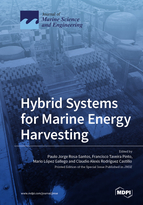Hybrid Systems for Marine Energy Harvesting
A special issue of Journal of Marine Science and Engineering (ISSN 2077-1312). This special issue belongs to the section "Ocean Engineering".
Deadline for manuscript submissions: closed (31 October 2021) | Viewed by 34035
Special Issue Editors
Interests: marine renewable energies; coastal and port engineering; physical and numerical modelling applied to offshore, port, and coastal issues; wave energy harvesting
Special Issues, Collections and Topics in MDPI journals
2. CIIMAR—Interdisciplinary Centre of Marine and Environmental Research, Marine Energy and Hydraulic Structures, 4450-208 Matosinhos, Portugal
Interests: coastal defense; coastal engineering; coastal structures; breakwaters; marine energy; integrated coastal zone management; nature-based solutions
Special Issues, Collections and Topics in MDPI journals
Interests: renewable energy; ocean engineering; marine structures; marine renewable energy
Special Issues, Collections and Topics in MDPI journals
Interests: offshore hydrodynamics; marine renewables; ocean engineering
Special Issues, Collections and Topics in MDPI journals
Special Issue Information
Dear Colleagues,
Technologies to harvest marine renewable energies (MREs) are at a pre-commercial stage, and significant R&D progress is still required in order to improve their competitiveness. Therefore, hybridization presents a significant potential, as it fosters synergies among the different harvesting technologies and resources. In the scope of this Special Issue, hybridization should be understood in three different manners: (i) combination of technologies to harvest different MREs (e.g., wave energy converter combined with wind turbine); (ii) combination of different working principles to harvest the same resource (e.g., oscillating water column with overtopping device to harvest wave energy); or (iii) integration of harvesting technologies in multifunctional platforms and structures (e.g., integration of wave energy converters in breakwaters, oil and gas platforms, or aquaculture platforms). The purpose of this Special Issue is to publish cutting-edge research on the development of hybrid technologies for MREs harvesting and to provide a rapid turn-around time regarding reviewing and publishing, disseminating articles freely for research, teaching, and reference purposes.
Dr. Paulo Jorge Rosa Santos
Dr. Francisco Taveira Pinto
Dr. Mario López Gallego
Dr. Claudio Alexis Rodríguez Castillo
Guest Editors
Manuscript Submission Information
Manuscripts should be submitted online at www.mdpi.com by registering and logging in to this website. Once you are registered, click here to go to the submission form. Manuscripts can be submitted until the deadline. All submissions that pass pre-check are peer-reviewed. Accepted papers will be published continuously in the journal (as soon as accepted) and will be listed together on the special issue website. Research articles, review articles as well as short communications are invited. For planned papers, a title and short abstract (about 100 words) can be sent to the Editorial Office for announcement on this website.
Submitted manuscripts should not have been published previously, nor be under consideration for publication elsewhere (except conference proceedings papers). All manuscripts are thoroughly refereed through a single-blind peer-review process. A guide for authors and other relevant information for submission of manuscripts is available on the Instructions for Authors page. Journal of Marine Science and Engineering is an international peer-reviewed open access monthly journal published by MDPI.
Please visit the Instructions for Authors page before submitting a manuscript. The Article Processing Charge (APC) for publication in this open access journal is 2600 CHF (Swiss Francs). Submitted papers should be well formatted and use good English. Authors may use MDPI's English editing service prior to publication or during author revisions.
Keywords
- hybrid technologies for marine renewable energy harvesting
- optimization of technologies using composite modelling (numerical modelling combined with experimental testing)
- integration of wave energy converters in breakwaters
- full-scale demonstration of technologies
- hybrid wave + wind technologies
- hybrid wave + solar technologies
- renewable energy
- ocean energy
- offshore engineering
- wave energy
- wind energy
- solar energy
- marine structures









